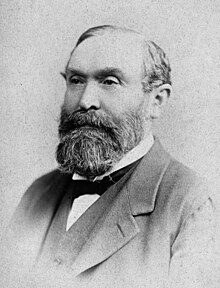William Rutherford (physiologist)


William Rutherford FRSE FRS FRCPE[1] (20 April 1839, Ancrum Craig, Roxburghshire – 21 February 1899, 14 Douglas Crescent, Edinburgh) was a Scottish physician and physiologist who was Professor of Physiology at Edinburgh University for 25 years, and contributed to the development of experimental physiology. He was Fullerian Professor of Physiology and Comparative Anatomy from 1872–75.
Life
William Rutherford was born at Ancrum in Roxburghshire. After studying in Berlin, Vienna, and Paris, he became assistant to John Hughes Bennett, Professor of Physiology at Edinburgh. After the Edinburgh anatomist John Goodsir told Rutherford about the new experimental physiology in Germany, William Rutherford and the ophthalmologist Argyll Robertson at Edinburgh became the first in the United Kingdom to introduce the new experimental apparatus of Hermann von Helmholtz, Emil du Bois-Reymond and Carl Ludwig.[2]
In 1869 Rutherford became Asst. Professor of Physiology at King's College, London. In 1871 he was appointed Professor of Physiology at the Royal Institution In 1874 he returned to Edinburgh University to succeed Bennett as Professor of Physiology there.[2]
Rutherford lectured at the University of Edinburgh when Arthur Conan Doyle studied medicine there. Like his fictional character Sherlock Holmes, who was based on a real person, Conan Doyle's Professor Challenger was based on Rutherford.
He died 21 February 1899 at 114 Douglas Crescent, Edinburgh and his body was buried at Ancrum.[3]
Works
- On the morbid appearances met with in the brains of thirty insane persons, 1869
- Influence of the vagus upon the vascular system, 1869
- Introductory lecture to the course of physiology in Kings College, London, 1869, 1869
- An introduction to the study of medicine : a lecture delivered at the opening of the medical session of 1871–72, in King's College, London, 1871
- The present aspects of physiology; an introductory lecture, 1874
- Outlines of practical histology : being the notes of the Histological Section of the Class of Practical Physiology held in the University of Edinburgh, 1875
- The sense of hearing: a lecture, 1886
- Syllabus of lectures on physiology, 1887
- A General account of histological methods, 1887
- On the conditions that influence the attainment of the physiological ideal : introductory lecture, 14 October 1890, 1890
- The tercentenary of the compound microscope; an inaugural address delivered 7 November 1890, to the Scottish Microscopical Society, 1891
- On the method of studying a natural science such as physiology : an introductory lecture, delivered 9 October 1894, 1894
Notes
- ^ Waterston, Charles D; Macmillan Shearer, A (July 2006). Former Fellows of the Royal Society of Edinburgh 1783–2002: Biographical Index (PDF). Vol. II. Edinburgh: The Royal Society of Edinburgh. ISBN 978-0-902198-84-5. Retrieved 15 December 2011.
- ^ a b John Gray McKendrick (20 April 1899). "William Rutherford". Nature. 59 (1538): 590–591. Bibcode:1899Natur..59..590J. doi:10.1038/059590a0..
- ^ Lee, Sidney, ed. (1901). . Dictionary of National Biography (1st supplement). London: Smith, Elder & Co.
References
- Richards, Stewart (May 1986). "Conan Doyle's 'Challenger' Unchampioned: William Rutherford, F.R.S. (1839–99), and the Origins of Practical Physiology in Britain". Notes and Records of the Royal Society of London. 40 (2). The Royal Society of London: 193–217. doi:10.1098/rsnr.1986.0011. JSTOR 531688. PMID 11620895.
External links
- Notes and Laboratory records of Professor William Rutherford (1839–1899), and Notes from Lectures given by Rutherford and taken down by others, held at the Edinburgh University Library, Special Collections Division
- 1839 births
- 1899 deaths
- 19th-century Scottish medical doctors
- People from the Scottish Borders
- Scottish physiologists
- Alumni of the University of Edinburgh
- Academics of the University of Edinburgh
- Academics of King's College London
- Fullerian Professors of Physiology
- Fellows of the Royal Society of Edinburgh
- Fellows of the Royal Society
- Fellows of the Royal College of Physicians of Edinburgh
